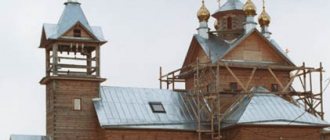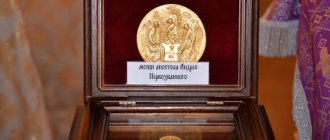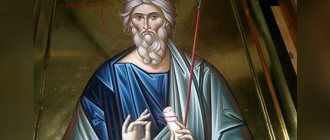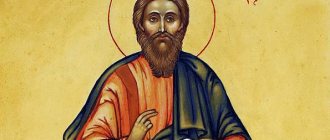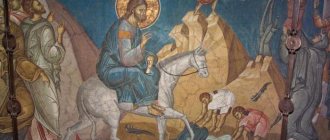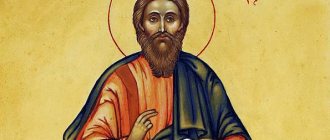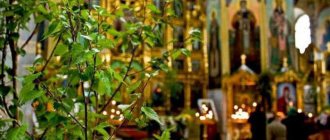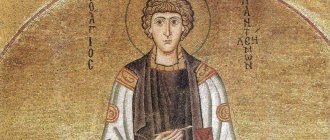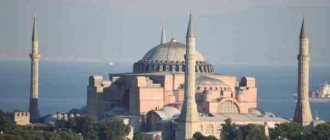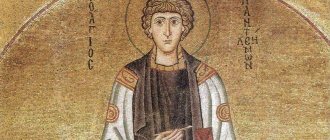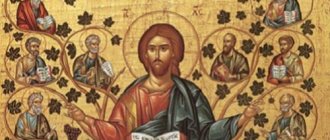"Save me, God!".
Thank you for visiting our website, before you start studying the information, please subscribe to our Orthodox community on Instagram, Lord, Save and Preserve † - https://www.instagram.com/spasi.gospodi/. The community has more than 60,000 subscribers. There are many of us like-minded people and we are growing quickly, we post prayers, sayings of saints, prayer requests, and timely post useful information about holidays and Orthodox events... Subscribe. Guardian Angel to you!
Orthodoxy is rich in the faces of Saints. Sometimes it can be difficult to figure out who to pray to and what to ask for. Each icon has its own purpose. For example, many have heard about the icon of St. Andrew the First-Called. What does it mean and what is it responsible for? Let's talk about everything in detail.
Life of St. Andrew the First-Called
In ordinary life, the Apostle Andrew the First-Called was called Andrei Zavedeev. He was a simple fisherman. He was often interested in various spiritual issues. When he met John the Baptist, he became his disciple. Many considered him the Messiah Himself. He denied this and said that he was the one who was preparing this path for Him. Andrew the First-Called and his brother followed the prophet.
One day, during a baptism in the Jordan, they saw their mentor pointing his finger at a man. He said that it was he who would take upon himself the sins of people. It was after this that Peter also joined the disciples of the Lord. For some time they still lived with their families and fished for food, although later they devoted themselves to serving God. There is not much information about Andrei himself; more information is about his actions.
Andrew the First-Called was next to the Lord throughout His entire life: at the Last Supper, after His Resurrection, at the Ascension of the Lord, and also the Holy Spirit descended on him at Pentecost. After this, all the apostles chose by lot the countries where they were to go to preach the Christian faith. He inherited the Black Sea coast and territory further north.
The best article for you, go to: Icon of the Archangel Gabriel meaning and what it helps with
Many historians believe that he was in Crimea, parts of Ukraine, Kuban and the Caucasus. Although there is no exact confirmation of this information.
Just like the rest of the apostles, his teaching met resistance from the pagans. Sometimes it even brought him not only spiritual, but also physical suffering.
In order to convince people of the correctness of following the Christian faith, Andrew the First-Called performed many miracles thanks to his prayers. Seeing such miracles, many people joined Orthodoxy.
During the persecution of Christians, Andrei returned to Rome. There he decided to defend and defend the Christian faith before the Roman governor Aegeat. In this dispute, Egeat said that the apostle would die the same death as his Teacher. He was captured and put in prison, where he awaited execution. People understood that he was innocent and even wanted to start a riot. But Andrei dissuaded them, saying that such suffering would bring him eternal glory.
He hung on the slanting cross for two days as an apostle and continued calling for humility and reading sermons. It was a painful death and after it he went to God.
Feast of St. Andrew the First-Called
Each saint has his own day of remembrance. So, the day of remembrance of the Apostle Andrew the First-Called is considered to be December 13 and July 13. It is on this day that many go to temples and read prayers.
History of the Holy Apostle
Andrew the First-Called became the first person to respond to the call of the teacher Jesus Christ to follow him, and therefore was awarded the name First-Called. With their brother, they grew up in a small town, where they became acquainted with the speeches of John the Baptist; by mistake, they considered him the Anointed One, whom the nations were waiting for.
The humble minister rejected their assumptions, leading the men to the real Messiah. They immediately accepted the truth he carried. And Andrei, filled with the truth, told Peter about it, who selflessly followed with them. But before they followed the Lord, they were ordered to return to their homes and complete the necessary tasks related to work and housekeeping. Jesus, catching them fishing, which was usual for men of that time, calls on them to go with him and become “fishers of men.”
As believers know, in the end, each apostle received the gifts of the Holy Spirit, that is, he had miraculous abilities. Each of them knew how to heal and perform other miracles. They continue this activity to this day. Therefore, the icon of St. Andrew the First-Called helps those praying in many ways: it heals ailments, improves relationships, and strengthens faith.
What do they pray to St. Andrew the First-Called?
Most often this Saint is approached with requests for:
- Conversion to Christianity
- Help for seafarers
- Defense of the Fatherland
- Help for foreign language teachers and translators
- Strengthening Faith
- Unity of the people under Christian leadership
- Happy marriage.
The best article for you, go to: The Icon of the Mother of God Gerontissa, what it helps with, what they pray for
How does Andrew the First-Called help? Most often, sailors and their families turn to him. Before going to sea, they even hold a service specifically for St. Andrew the First-Called. This is done so that he helps them on the hike, as well as for a safe return home. The flag of the navy also depicts the St. Andrew's Cross.
Day of Remembrance
Memorial Day of the Apostle according to the church calendar is December 13, November 30 in the old style.
Faith and fidelity
The highest state award of the Russian Federation is the Order of St. Andrew the Apostle, this Order is awarded for outstanding services that contribute to the prosperity, greatness and glory of Russia. The motto placed on the reverse side of the Order: “For faith and fidelity.”
The apostle himself had great faith and fidelity to God, and even if we are not worthy to reach the Order, we can always beg Saint Andrew to help us strengthen our faith and fidelity to the Lord Jesus Christ. Maybe through the prayers of the holy apostle we will be lucky enough to know Christ in this life, which is greater than all rewards.
Author: Irina Nechaeva
Icon of St. Andrew the First-Called
There are many icons and copies of the Apostle Andrew the First-Called in the world. Here are some temples where you can see such holy faces:
- Church of the Apostle Andrew the First-Called in Moscow at the Vagankovskoye cemetery. There is a revered icon of this Saint.
- Church of the Mother of God “Joy of All Who Sorrow” on Ordynka, where the icon with a piece of relics is located
- Temple of Sioni (Assumption of the Mother of God) in Georgia, where the myrrh-streaming icon is located
- Patriarchal Cathedral of the Holy Trinity in Tbilisi. The icon that is there is unusual. It is carved from wood.
There are also other venerated relics and icons of this Saint. They are:
- Pyzhki Moscow - St. Nicholas Church
- Kuzminki Moscow - Temple of the Blachernae Icon of the Mother of God
- Golyanov – Church of St. Zosima and Savvaty of Solovetsky
- Diveevo - Church of St. Andrew the First-Called.
You can pray to this Saint at the image of his face. And here is the prayer itself to the Apostle Andrew the First-Called:
First-Called Apostle of God and our Savior Jesus Christ, Church follower, all-praised Andrew! We glorify and magnify your apostolic works, we sweetly remember your blessed coming to us, we bless your honorable suffering, which you endured for Christ, we kiss your sacred relics, we honor your holy memory and believe that the Lord lives, and your soul lives and is with Him. forever remain in heaven, where you love us with the same love with which you loved us, when by the Holy Spirit you saw our conversion to Christ, and not only loved, but also prayed to God for us, in vain in His light all our needs.
Thus we believe and thus we confess this faith in the temple, which in thy name, Saint Andrew, was most gloriously created, where thy holy relics rest: believing, we ask and pray to the Lord and God and our Savior Jesus Christ, that through thy prayers he may ever hear and he accepts and will give us everything we need for the salvation of us sinners: yes, as you are, according to the voice of the Lord, leave your hesitation, you have steadfastly followed Him, and let everyone from us seek not his own, but for the creation of his neighbor and for the heavenly calling, yes thinks.
Having you as an intercessor and prayer book for us, we hope that your prayer can accomplish much before our Lord and Savior Jesus Christ, to Him belongs all glory, honor and worship with the Father and the Holy Spirit and forever and ever. Amen.
It doesn’t matter what words you use to ask for help. The main thing is that they come from a pure heart.
The Lord is always with you!
The best article for you, go to: Icon of St. Gerasimos of Jordan
Watch the video about the Holy Apostle Andrew the First-Called:
What does the iconographic image of the first of the apostles look like?
Iconography: Andrew the First-Called, Apostle
Dating: XVIII century. Last third of the 18th century.
Icon painting school or art center: Olonets province.
Icon painter: Old Believer master.
Origin: From the chapel of the Apostle John the Theologian in the village of Zekhnov, Kenozero parish.
Material: Wood, gesso, tempera, gilding
Icon dimensions: height 46 cm, width 34 cm
Icon of the Deesis order. Half-length image of the Apostle Andrew the First-Called.
Inv. No. KP 9. © Kenozersky National Park
The icon of St. Andrew the First-Called is a portrait of a happy man who met Christ in his life and gave it all to serving Him, walking his path meaningfully and not in vain.
Useful materials
He was the first of His disciples to exclaim: “We have found the Messiah, which means Christ” (John 1:41),
and brought brother Peter to the Savior, for which he was called the First Called (in Greek “
Protokletos
”). The path of his life was difficult, on the cross, full of hardships and adversity, but it became the fulfillment of the will of God to bring the Gospel word to all languages and to build a new Church:
“ You are a chosen race, a royal priesthood, a holy nation, a special people, that you may proclaim the praises of Him who called you out of darkness into His wonderful light ” (Pet. 2:9) .
Apostle Andrew the First-Called
On icons, Saint Andrew is often depicted with a cross in his hand, or with an oblique cross behind his back. The cross on the icon symbolizes his martyrdom. In the Orthodox tradition, icons with crosses depict those who suffered for the faith of Christ. Saint Andrew the First-Called died as a martyr in the city of Patras in the year 62. According to legend, the apostle was crucified on an oblique cross in the shape of the letter X.
Interesting fact
This cross has since been called St. Andrew's and is depicted on the flag of the Russian fleet.
The saint died for a long time, several days, however, he evaded the help of his disciples, who tried to save him and rebelled against the tyrant and tormentor Egeat. Those instructed by the apostle in the faith tried to save their teacher from death and take him down from the cross, but Andrew, who loved the Cross of Christ more than anything else in the world, said to them:
“Oh, what cowardice and foolishness there are in those whom I taught so much! Have you not yet convinced them to deviate from earthly passions? Do they still want to stay in them? How long will you be upset by what is before your eyes, without directing your spirit to what awaits us in the future? Let me end my life as the Lord judged me; no one will free me from these bonds, for this is my calling: to strip off this body and strive to the Lord, for whose sake and with whom I am crucified.”
In addition to the cross on the icon, Saint Andrew holds in his hand a scroll - Divine Scripture, or a book - the Gospel, which symbolizes his apostolic, teaching work. A book or scroll, which is the same thing, on icons is always a symbol of educational activity, belonging to mentors and teachers of the Church, saints, apostles and the Lord Jesus Christ Himself - the Divine Teacher.
Apostle Andrew the First-Called. Greek fresco, Fr. Cyprus, XI century Apostle Andrew the First-Called. Greek fresco, Fr. Cyprus, XI century
On the icons the saint is depicted dressed in an apostolic tunic, with a distinctive feature - a clave, such a sewn stripe on the shoulder, and with a himation thrown over it - something like a cape or cloak.
The face of the apostle is especially interesting and expressive in the icon. His appearance is courageous, which corresponds to the name that the saint bore; in Greek, Andrew means courageous. The face is open, the eyes are wide open, the feature is thick tousled hair, which gives the appearance of expression, a character of determination and activity.
And indeed, from the life of the apostle according to various sources, incl. and apocryphal, it is known that he went preaching to distant countries, moving thousands and thousands of kilometers away from Jerusalem and his native Bethsaida, bringing the word of God to the pagans and the most savage peoples, according to legend - even to cannibals.
A simple fisherman from Lake Gennesaret needed to have great strength of spirit, strong faith and strength of character, as well as physical strength, in order to bring the word of Truth to people in distant lands, being a stranger to them. The strength and activity of the character of the Apostle Andrew is embodied in his emotional image on the icons. Only the images of the Old Testament prophets are conveyed with the same pathos in the church tradition.
According to the testimony of the hagiographer monk Epiphanius, who compiled a description of the acts of the Apostle Andrew in the 9th century and borrowed data from various sources, the appearance of the apostle, fisherman and navigator, was such that he was of considerable height, but was somewhat bent, had thick hair and eyes, clear, filled with blessed light, the nose was like an eagle. So Epiphanius writes that Andrei was “ tall, but sat, brow, a little hunched over
».
These brief characteristics correspond to the purposeful Andrew, with a burning heart awaiting the Messiah, who, having heard from his teacher John the instruction “ Behold, Lamb of God, take away the sins of the world” (John 1:29),
immediately went after Jesus. And when he was with Christ and heard His words, he immediately called others:
“First find this brother Simon, and say to him: I have found the Messiah, who is, so to speak, Christ” (John 1:41).
Having taken upon himself the cross of apostolic service, and to all the other people he met on the path of life, Andrei revealed the good news about the Savior and led everyone after Him with his ardent preaching.
Apostle Andrew the First-Called and Evangelist John the Theologian
In ancient Russian art, the image of the Apostle Andrew is fixed in a stable iconographic type, representing the saint as gray-haired, with a forked, not very long beard, in yellow-green shades of vestments, with a scroll in his hands. A Russian icon painting from the 16th century describes his image as follows:
“The Holy Glorious and All-Valuable Apostle Andrew the First-Called, thick hair like Flora’s, brad around the hem of the Theologian, gray-haired, in two small, a sankir robe with whitewash, from the waist a robe with whitewash, holding a scroll, curled with both hands, with the left hand of the robe draped, bare feet "
Earliest images
Ap. Andrey. Mosaic of the oratory of the Archbishop's Chapel. Ravenna. 494–519
The most ancient images of St. Andrew are known as wall paintings: mosaics in Ravenna (Italy), in the dome of the baptistery (5th century), in Sinai in the apse of the catholicon of the monastery of the Great Martyr. Catherine (550–565), the mosaic image of Andrew occupies the most honorable place, paired with the Apostle Paul. The image of the apostle was preserved on frescoes in the apses of the chapel in Bauita (Egypt, 6th century), in the church of Santa Maria Antiqua in Rome (705–707), and other places.
Many ancient images of St. Andrew have been preserved in Russia, where since ancient times he has been considered their Russian apostle and the founder of our Church.
Iconography in Rus'
It is known from life that according to the apostolic lot, Saint Andrew was given the north-eastern lands for preaching. He went to Thrace, Macedonia, Scythia. He walked along the Dnieper to the site of the future city of Kyiv, where he installed the Holy Cross on the mountain and blessed the future glorious city. There is a tradition that the apostle reached Novgorod and Valaam, there is no evidence of this, but why not consider church tradition, the ancient readings of the Prologue, the early establishment of services to the saint, the many churches dedicated to him in Rus' and the people's love for him as proof of the illumination of the Russian land by the apostolic preaching? Andrey.
Already at the beginning of the 11th century, in the princely family of the Monomakhovichs, there was veneration of St. Andrew as a patron. The son of Yaroslav the Wise, Vsevolod, was given the Greek name Andrei at baptism, and further princes Andrei appeared in the family.
Apostle Andrew the First-Called and Holy Prince Andrei Bogolyubsky
Interesting fact
In 1086, the St. Andrew's Monastery was founded in Kyiv, and a few years later a temple was founded in Novgorod. In 1089, a stone cathedral in the name of St. Andrew the First-Called in Pereyaslavl was consecrated.
The perception of Saint Andrew as our Russian apostle, who laid the foundation in Russia of the Orthodox Church, which became an equal sister to the other Orthodox churches of the West and East, is enshrined in the literary tradition by the tale of the Tale of Bygone Years - “The Word about the Baptism of the Russian land by the Holy Apostle Andrew, as he came to Russia.”
The oldest Russian icon depicting the apostle can most likely be considered the “Assumption of the Mother of God” painted in the Kiev-Pechersk Monastery (circa 1073). The ancient image has not been preserved, but is known only from copies. Among them, the most famous repetition is the “Assumption” of 1671 (Trinity-Sergius Lavra, museum collection), painted by Simon Ushakov, and the image of Kirill Ulanov of 1702 with an enamel frame on the margins (State Tretyakov Gallery). The four apostles especially stand out in the composition: John the Theologian bending towards the head of the Mother of God, Peter next to the censer, Paul hugging the foot, and finally Andrei, emotionally gesticulating.
Already in those distant times, the Greek name Andrei was one of the most common in Rus', so personalized icons of the heavenly patron of sons were probably ordered for princely and boyar families. An example is the personalized Moscow icon “Archangel Michael and Apostle Andrew the First-Called” (third quarter of the 16th century) from the Museum of the Trinity-Sergius Lavra.
The image of St. Andrew was placed in the iconostasis of churches in the Deesis row. Among such surviving images, one should mention the icon of the letter of Andrei Rublev and his students in the iconostasis of the Assumption Cathedral of Vladimir (1408). In Rublev’s Deesis procession, the apostle is depicted together with John the Theologian, and is depicted without expression, but, on the contrary, in concentrated prayer and in high, blissful silence. Unfortunately, the icon was poorly preserved and is currently in the State Tretyakov Gallery.
Or the icon of Andrew, also from the Deesis rank (in half rotation) in the Trinity Cathedral of the Holy Trinity Lavra of St. Sergius (1425–1427). And also an icon of the 15th century from the iconostasis of the Assumption Cathedral of the Kirillo-Belozersky Monastery, stored there, in the Kirillo-Belozersky Historical, Architectural and Art Museum-Reserve in the city of Kirillov, Vologda Region.
Particularly revered shrines associated with the name of the holy apostle are also preserved in the Orthodox Church of Greece, in the city of Patras, where part of his venerable head and his cross is located, and on Mount Athos. In 2016, a copy of the icon of St. Andrew the First-Called, revered by Orthodox believers, was brought to Russia from the city of Patras, with a particle of the relics of the holy apostle and the cross on which he was crucified. There are especially revered icons with particles of the saint’s relics in Russian churches.
18
July
2013
A monument to the Apostle Andrew the First-Called was solemnly unveiled in Kharkov.
Particularly revered images in Moscow
In Moscow, especially revered icons of the saint are:
- In the Church of the Icon of the Mother of God “Joy of All Who Sorrow” on Bolshaya Ordynka in Moscow, address: st. B. Ordynka, 20, nearest metro station Tretyakovskaya. Here is the revered image of the Apostle Andrew the First-Called with a piece of his relics.
- In the church of St. Vmch. Nikita behind the Yauza (Athos Compound); address: st. Goncharnaya 6, nearest metro station Taganskaya. On the territory of the courtyard there is also a church of St. ap. Andrew the First-Called in the clergy house (Goncharnaya St., 4). The courtyard houses especially revered icons with particles of the relics of St. ap. Andrew the First-Called, as well as St. St. Silouan of Athos, St. Vmch. Panteleimon.
- In the church of St. Nicholas in Pyzhi, address: st. B. Ordynka, 27a/8, nearest metro station. Tretyakovskaya, Novokuznetskaya. The temple contains a particle of the relics of St. Andrew the First-Called.
- In the Church of St. Andrew the First-Called at the Vagankovsky cemetery, at the address: st. Sergeya Makeev, 15, metro station “Ulitsa 1905 Goda”, there is a revered icon of St. Andrew.
- In the Epiphany Cathedral in Yelokhov. Address: st. Elokhovskaya, 15, Baumanskaya metro station. In the temple under the Crucifixion of the 19th century, there is a metal shrine with a particle of the Tree of the Life-Giving Cross of the Lord, the right hand of St. Andrew the First-Called, head of St. John Chrysostom, particles of the relics of St. Nicholas the Wonderworker and Metropolitan. St. Petra. Since 1731, the church has housed the especially revered image of the Mother of God “Joy of All Who Sorrow.”
- In the Cathedral Church of Christ the Savior. Address: st. Volkhonka, 15, Kropotkinskaya metro station. Here, among the many shrines, there is an icon and relics (particle) of St. Andrew the First-Called.
Childhood and adolescence
The famous preacher was born presumably in the 5th year of Christ in the north of Israel in the historical region of Galilee.
His hometown of Bethsaida was located on the shores of Lake Gennesaret near the confluence of the Jordan River. He became the second child in the family of fisherman Ion and Joanna, who were already raising Simon (the future St. Peter). Parents raised their sons in a Christian spirit, from childhood they taught them to work, mercy, patience, and meekness. When the brothers grew up, they moved to the fishing village of Capernaum, where they made a living, like their father, by fishing.
Calling of Peter and Andrew by Jesus
The younger brother was distinguished by his special desire to serve God, therefore, having learned about the prophet John the Baptist, who preached about the imminent coming of the Messiah, he took a place among his followers. During the baptism of people in the Jordan, his meeting with the Lord took place. The teacher then pointed to Jesus and called him the lamb of God, who decided to sacrifice himself for the salvation of mankind. The young man, together with John of Zebedee (later St. John the Theologian), who was standing next to him, heard this and immediately followed the savior. He became his first, first-called disciple, accepted for a special education - preparation for righteousness, for the perception of the spirit of truth and for the mission of preaching the Gospel. Soon Andrei convinced his older brother to become a disciple of Christ.
Meeting with the Savior
Not much is known about the life of the saint before meeting Christ; this information is mainly taken from the apocrypha. The brother of the future Apostle Peter, Andrei was also a fisherman. A pious man, he decided not to marry, devoting himself to God. At first, Andrei was a disciple of John the Baptist, and then he heard for the first time about the Son of God. According to the Gospel, Christ called the brothers as he passed by. They immediately dropped everything and followed. Such was the power of Jesus' calling.
On the icons, Andrew the First-Called is depicted as an old man with a long gray beard. Perhaps he was the same age as Christ, since his death occurred around 70. The Lord gave his disciples a very specific task - to enlighten all the peoples inhabiting the earth with the light of the Gospel. To carry out the assignment, they cast lots and went in different directions. Andrey got the Black Sea region.
Work as a courier at Yandex.Eda (up to 3,400 rubles per shift) leave a request →
You must understand that traveling in those days was an extremely long, tedious and dangerous undertaking. Not to mention how difficult it is to convert people to a new faith. Even modern people perceive such attempts with hostility, but back then people were deprived of their lives for this - and on legal grounds. After all, in the Roman Empire, which then ruled everywhere, paganism was legalized.
The first Christian preacher in Rus'
Andrew the First-Called, according to legend, was the first and only of Christ’s disciples to visit the lands of future Rus'. Although some historians question the story of the journey of the Apostle Andrew from the Black Sea coast to the north, to the future Novgorod, in the tradition of the Russian Orthodox Church it is customary to consider Andrew the First-Called the first Christian preacher in Rus'. According to the Tale of Bygone Years of the 12th century, the Apostle Andrew climbed along the Dnieper to the place where the city of Kiev now stands, spent the night in this area, and the next morning announced to the disciples traveling with him: “Do you see these mountains? On these mountains the grace of God will shine, there will be a great city, and God will erect many churches,” after which he climbed these very mountains, blessed them and planted a cross. Having passed upstream, Andrew the First-Called reached the shores of Ladoga and from there, through Western Europe, returned to Rome, and then moved to the Peloponnese Peninsula, where in the 60s of the first century he died: he was crucified on an oblique cross. His image is forever fixed on the St. Andrew's flag.
The personality and deeds of the Apostle Andrew became the most important bridge that even today connects the Church of Constantinople with the Russian Orthodox Church. The name of Andrew the First-Called overshadowed many Russian princes, starting with Vsevolod Yaroslavich, the son of Yaroslav the Wise, who was baptized in 1030 under the name Andrey, and in 1086 founded the St. Andrew's Monastery in Kyiv. At the same time, the memory of the Holy Apostle Andrew the First-Called was included in all types of Russian calendars.
In 1621, an Orthodox Council was held in Kiev, in the Acts of which it was written: “Since the holy Apostle Andrew is the first Archbishop of Constantinople, the Ecumenical Patriarch and the Russian Apostle, and his feet stood on the Kiev mountains, and his eyes saw Russia and his lips blessed... then just and it will be a godly deed to restore his holiday solemnly and deliberately. Truly, Russia is no less than other eastern nations, for the apostle preached there too.” And the first Russian emperor Peter the Great, who revered St. Andrew as his heavenly patron, when founding the new capital - St. Petersburg - laid a reliquary with a piece of the relics of St. Andrew the First-Called in the foundation of the fortress on Hare Island.
Photo: Smityuk Yuri/TASS
Peter I established the first and for almost 20 years the only state award of the Russian Empire - the Imperial Order of St. Andrew the First-Called Apostle. And almost immediately after this, the emperor introduced the official flag of the Russian Navy: white with a blue St. Andrew's Cross. It was under this flag that Russian ships made many famous voyages and geographical discoveries, including the discovery of Antarctica in 1820, and many legendary exploits.
